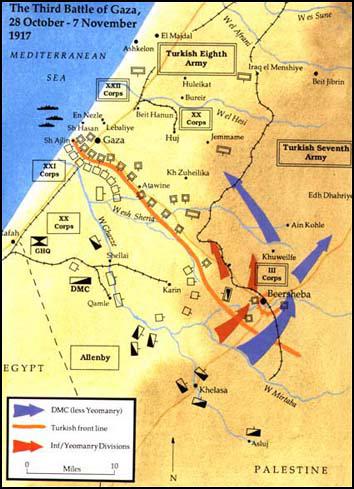Battle of Gaza
After occupying El Arish in Sinai in December 1916, the ANZAC mounted division led British forces up to the Palestine border. With his forces needed elsewhere, General Archibald Murray, Commander in Chief of the British Forces in the Middle East, postponed making further advances.
General Friedrich Kressenstein, commander of the Turkish Expeditionary Force, occupied the coastal fortress of Gaza, blocking the main route into Palestine. General Murray was determined to take Gaza and sent General Dobell, commander of the Eastern Forces, in March 1917. Kressenstein had 18,000 men but was outnumbered 2 to 1 by Dobell's forces.
General Dobell massed the main bulk of his men 8km from Gaza. Undetected in a dense sea fog, Dobell's cavalry was able to cut off the town's rear on the 26th March. The main infantry attack that followed was less successful. A Turkish counterattack and water shortages forced Dobell to order his men to retreat. General Dobell lost 4,000 men against about 2,400 Turkish and German casualties. Dobell estimated that the Turks lost three times that number and at the time the battle was reported as a British victory.
In June 1917, General Edmund Allenby was transferred from the command of the Third Army in France to become commander of the British Forces in Palestine. Lieutenant-General Harry Chauvel was given command of the Desert Mounted Troops and the infantry divisions were allotted to Lieutenant-General Philip Chetwode (XX Corps) and Major General Edward Bulfin (XXI Corps).
The British plan was for a preliminary operation against Beersheba to enable them to take the higher ground. Once established at Beersheba the forces would be deployed to roll-up the Turkish flank. Chetwode and XX Corps and the Desert Mounted Corps formed the main striking force, whereas Bulfin and XXI Corps would make the attack on Gaza itself.
On the night of 30th October, over 40,000 Australian and British troops moved into position for the attack on Beersheba. It was hoped that the diversionary attack would encourage the Turks to reinforce their right at expense of their left and make it easier for the XX Corps. Gaza was also bombarded by French and British ships offshore.
The first phase of the assault on Beersheba began early on 31st October. By late afternoon the Allied forces had driven the Turks back into Gaza. At 4.30 pm Brigadier Grant led two cavalry regiments against the eastern defences of the town. Although faced with Turkish machine-guns, the cavalry managed to gallop into Beersheba. The Turks were captured before their plans to destroy the wells and evacuate the town could take place.
The main attack against the Turkish left took place on 6th November. Although the Turkish trenches ran for eight miles all Allied objectives were taken by mid-afternoon. That evening the Turks began to retreat. When XXI arrived on the morning of 7th November, Gaza had been abandoned.
General Allenby's victory at Gaza had unlocked the defences of the Turks. In the weeks that followed, the Turks retreated 75 miles and on 9th December the allied forces took Jerusalem. Although a clear victory, between October and December, 1917, the British and Empire forces lost 19,702 men during the campaign in the Middle East.

Primary Sources
(1) Derby Evening Telegraph (1939)
Arsenal have a big problem. Spending £14,000 on Bryn Jones has not brought the needed thrust into the attack. The little Welsh inside-left is clearly suffering from too much publicity, and is obviously worried. He is a nippy and quite useful inside-left, but his limitations are marked.
